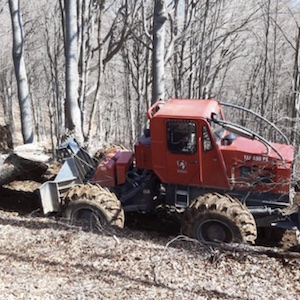Productivity analysis and costs of wheel cable skidder during salvage logging in European beech stand

Published: 1 August 2023
Abstract Views: 800
PDF: 362
HTML: 89
HTML: 89
Publisher's note
All claims expressed in this article are solely those of the authors and do not necessarily represent those of their affiliated organizations, or those of the publisher, the editors and the reviewers. Any product that may be evaluated in this article or claim that may be made by its manufacturer is not guaranteed or endorsed by the publisher.
All claims expressed in this article are solely those of the authors and do not necessarily represent those of their affiliated organizations, or those of the publisher, the editors and the reviewers. Any product that may be evaluated in this article or claim that may be made by its manufacturer is not guaranteed or endorsed by the publisher.
Similar Articles
- Gabriella Impallomeni, Francesco Barreca, Agrivoltaic systems towards the European green deal and agricultural policies: a review , Journal of Agricultural Engineering: Vol. 56 No. 1 (2025)
- Davide Boscaro, Andrea Pezzuolo, Stefano Grigolato, Raffaele Cavalli, Francesco Marinello, Luigi Sartori, Preliminary analysis on mowing and harvesting grass along riverbanks for the supply of anaerobic digestion plants in north-eastern Italy , Journal of Agricultural Engineering: Vol. 46 No. 3 (2015)
- Juan Ãngel Mintegui Aguirre, José Carlos Robredo Sánchez, Carlos de Gonzalo Aranoa, Pablo Huelin Rueda, Jorge Fallas, Felipe Cisneros, Pedro Cisneros, Adriana Urciuolo, Rodolfo Iturraspe, Forest use strategies in watershed management and restoration: application to three small mountain watersheds in Latin America , Journal of Agricultural Engineering: Vol. 45 No. 1 (2014)
- Francesco Bettella, Tamara Michelini, Vincenzo D'Agostino, Gian Battista Bischetti, The ability of tree stems to intercept debris flows in forested fan areas: A laboratory modelling study , Journal of Agricultural Engineering: Vol. 49 No. 1 (2018)
- Qingyu Chen, Rui Kang, Naishuo Wei, Yunlei Fan, Zeyu Wang, Yu Chen, Jun Chen, Design and experiment optimize of the vibration harvesting machine of Lycium barbarum L. , Journal of Agricultural Engineering: Vol. 55 No. 4 (2024)
- Remo Alessio Malagnino, Performance analysis of photovoltaic plants installed in dairy cattle farms , Journal of Agricultural Engineering: Vol. 46 No. 2 (2015)
- Emanuele Cerruto, Giuseppe Manetto, Giampaolo Schillaci, Vibration produced by hand-held olive electrical harvesters , Journal of Agricultural Engineering: Vol. 43 No. 2 (2012)
- Kamalesh Kanna S, Kumaraperumal Ramalingam, Pazhanivelan P, Jagadeeswaran R, Prabu P.C., YOLO deep learning algorithm for object detection in agriculture: a review , Journal of Agricultural Engineering: Vol. 55 No. 4 (2024)
- Alessandro Parenti, Paolo Spugnoli, Piernicola Masella, Lorenzo Guerrini, Stefano Benedettelli, Stefano Di Blasi, Comparison of grape harvesting and sorting methods on factors affecting the must quality , Journal of Agricultural Engineering: Vol. 46 No. 1 (2015)
- Fuhao Zhu, Jin Chen, Zhuohuai Guan, Yahui Zhu, Hao Shi, Kai Cheng, Development of a combined harvester navigation control system based on visual simultaneous localization and mapping-inertial guidance fusion , Journal of Agricultural Engineering: Vol. 55 No. 3 (2024)
You may also start an advanced similarity search for this article.

 https://doi.org/10.4081/jae.2023.1419
https://doi.org/10.4081/jae.2023.1419 











